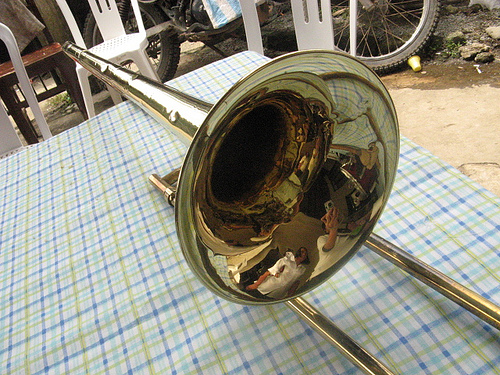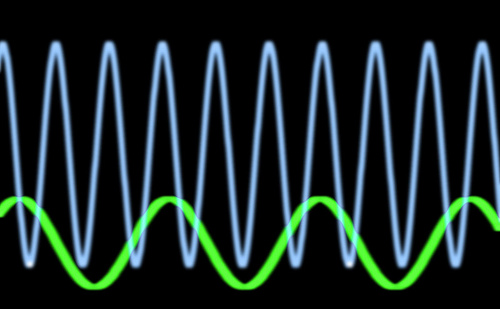What is a Note?
A Bird's Ear View of the Musical Note
Written by: Larry Coffey

The musical note is the basis of all Western music. A wide variety of instruments are manufactured to create sounds each with an individual timbre and color. Brass, woodwinds, strings, and even many percussion instruments may issue distinctive tones, but they all have one thing in common: the ability to emit a note.
When notes are played in sequence or in concordance with others, the music that is created has the power to evoke strong emotions and elicit stirring memories from the listener. Whether it's your prom theme, the song for your first dance at your wedding, or just a silly happy ditty that makes you jump around, it's the notes of the song that create that atmosphere for you.
So, let us explore exactly what a note is...
Table of Contents
Note Physics
A musical note is a single tone of a specified pitch that is sustained for a given duration. For example, pressing a single key on the piano and, assuming it is in tune, will sound a musical note. Hold the piano key for a bit, and the note will sustain until it fades.
The pitch of the note is given a name, things like "Middle C" or "B-flat". A note is really just sound waves, caused by some sort of vibration, of a specified wavelength. The source of the vibration could be as diverse as a string (piano, guitar, violin), a reed (clarinet, sax), or even lips against metal (trumpet, trombone, tuba).
The number of those vibrating waves that hit your eardrum each second is called the "frequency". Below is a table that shows the names of some notes and their respective pitch frequencies in hertz (cycles per second).
| Note Name | Frequency (in Hertz) |
|---|---|
| Middle C | 261.63 |
| C#/Db | 277.18 |
| D | 293.66 |
| D#/Eb | 311.13 |
| E | 329.63 |
| F | 349.23 |
| F#/Gb | 369.99 |
| G | 392.00 |
| G#/Ab | 415.30 |
| A ("Concert Pitch") | 440.00 |
| A#/Bb | 466.16 |
| B | 493.88 |
| C | 523.25 |
Note Notations
The duration of a note depends on the tempo of the music. Notationally, music is written with a time signature, tempo annotation, and a graphical representation depicting quarter notes, eighth notes, half notes, and other goodies like ties and dots and much more. I'm not going to go into how to read music here - but a quick look at how musicians represent notes in written works is worthwhile.
| Note Symbol | Note Name | Alternate Name |
|---|---|---|
 | Whole Note | Semibreve |
 | Half Note | Minim |
 | Quarter Note | Crotchet |
 | Eighth Note | Quaver |
 | Sixteenth Note | Semiquaver |
 | Thirty-Second Note | Demisemiquaver |
 | Sixty-Fourth Note | Hemidemisemiquaver |
Exceptions
Like so many hard and fast rules in the world, music has many exceptions, too. Presented below are just a couple of special cases to the "this note" is "this pitch" rule.

Slurs and Slides - Musical notation allows for playing one note and moving to another in the same breath for wind instruments. This is sometimes called slurring. The physical construction of most wind instruments, though, usually prevents a truly smooth transition from one pitch to another. For those, a slur is more-or-less a breathless transistion between two notes. See also glissando for more information on gliding from one pitch to another.
A slide trombone, as its name implies, does not have this limitation. In fact, this unique feature of a trombone has been taken advantage of by many composers. The distinctive sound of the low brass slide is immediately recognizable, lending an air of anticipation to the listener as the dissonance resolves into a standard pitch.
Fretless stringed instruments, violins, violas, cellos, standup basses, etc., have similar abilities to slide into notes. If a musician's finger slides up or down a string while sounding a note (i.e. bowing or plucking the string), then a smooth transition between the two notes occurs. Like with the trombone, many composers take advantage of this ability to create a particular atmosphere or feeling to their composition.
A fret is raised strip on the fingerboard of a stringed instrument, used to terminate a string's vibration at a designed location rather than the finger itself. Thus, if a finger is placed anywhere between the boundary of two frets the same note sounds: regardless of how close or how far the finger may be from the fret.

The Bends - Any instrument with strings directly exposed to the musician lends itself to bending. This holds true for both fretted and fretless instruments, including guitars, violins, and cellos. Though a piano is sometimes classified as a stringed instrument, the strings themselves are not directly accessable (usually) to the musician and therefore can't be bent.
Probably the most prevalent form of pitch bending occurs in rock music, where skilled guitarists can bend a pitch by pushing a string either before or after striking the string. Furthermore an entire chord can be bent with the use of a tremolo arm. One only needs to listen to the great masters like Jimmy Page, Jimi Hendrix, or Carlos Santana to hear these virtuosos provide excellent examples of effective and stirring pitch bending.

The Octave
A note that is an octave above another note is physically double the frequency of that first note. In fact, technically, octaves are just doubling or halving frequencies of a note's pitch. Both notes are given the same name, though notationally they are sometimes identified with a numerical subscript to identify which octave they belong to. For example, a concert "A" is 440 hertz. The "A" one octave above it is 880 hz, and the one below it is 220 hz.
By convention in Western music, between those two pitches, lie twelve equally spaced "half-steps" (see the table above under Note Physics, for the names of each of those notes).
It are these simple twelve notes, plus the concept of octaves, that make up the whole of Western music. Whether it's crashing rock and roll, bouncing pop, or hot jazz, it's the same twelve notes! And that's pretty cool once you think about it.
Photo Credits:
Piano Keys by Nina Matthews Photography
Sine Waves by Creativity103
Trombone by Pale Lips
Guitar Model by Nina Frazier
All others Copyright (c) 2010 SillyTutu.com
